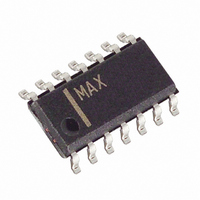MAX3292ESD+ Maxim Integrated Products, MAX3292ESD+ Datasheet - Page 11

MAX3292ESD+
Manufacturer Part Number
MAX3292ESD+
Description
IC TXRX RS485/422 10MBPS 14-SOIC
Manufacturer
Maxim Integrated Products
Type
Transceiverr
Datasheet
1.MAX3292EPD.pdf
(16 pages)
Specifications of MAX3292ESD+
Number Of Drivers/receivers
1/1
Protocol
RS422, RS485
Voltage - Supply
4.75 V ~ 5.25 V
Mounting Type
Surface Mount
Package / Case
14-SOIC (3.9mm Width), 14-SOL
Operating Supply Voltage
5 V
Mounting Style
SMD/SMT
Product
RS-422/RS-485 Combination
Lead Free Status / RoHS Status
Lead free / RoHS Compliant
The MAX3291 has an internal fixed preemphasis interval
of 100ns. Use the MAX3291 for existing designs requiring
industry-standard ’75180 pin-compatibility at data rates of
5Mbps to 10Mbps.
The MAX3292 has a resistor-programmable preemphasis
interval for more flexibility. For data rates less than 1Mbps,
use the following equation to calculate R
emphasis setting resistor):
where t
For example, a baud rate of 500kbps produces a baud
period of 2µs (2µs = 2000ns).
For data rates of 1Mbps to 10Mbps, use the following
equation to calculate R
where t
For example, a baud rate of 1Mbps produces a baud
period of 1µs (1µs = 1000ns).
Set the preemphasis interval by connecting the R
resistor from PSET to V
tor (C
directly to V
reverts to the nominal 100ns value.
Figure 14. Preemphasis Driver Performance Compared to a
Conventional Driver Without Preemphasis at 10% Jitter
R
(closest standard value is 523kΩ)
PSET
PSET
for High-Speed, Long-Distance Communication
RS-485/RS-422 Transceivers with Preemphasis
BAUD
R
BAUD
10,000
1000
PSET
100
R
R
= 580 (1000 - 100)(1000 / 1000) = 522kΩ
) from PSET to V
PSET
PSET
CC
Setting the Preemphasis Interval
= one baud period in ns.
0.1
= one baud period in ns.
= 580 (t
R
24-GAUGE
TWISTED PAIR
PSET
(R
= 580 (t
= 580 (2000 - 100) = 1.1MΩ
______________________________________________________________________________________
PSET
= 580 (t
CONVENTIONAL
BAUD
PSET
DATA RATE (Mbps)
CC
= 0), the preemphasis interval
485 DRIVER
BAUD
PREEMPHASIS REQUIRED
FOR ERROR-FREE
TRANSMISSION
. Use a 0.1µF bypass capaci-
:
- 100)(t
LIMIT
1
CC
BAUD
- 100)
. If PSET is connected
PREEMPHASIS
10% JITTER
- 100)
BAUD
485 DRIVER
LIMIT
/ 1000)
PSET
10
(the pre-
PSET
One simple method to quickly determine your circuit
configuration is to view an eye diagram. An eye dia-
gram is a scope photo (voltage vs. time) showing the
transitions of a pseudo-random bit string displaying at
least one bit interval. Use an eye diagram to quickly
calculate the total jitter of a circuit configuration. Jitter is
the total time variation at the zero-volt differential cross-
ing, and percent jitter is expressed as a percentage of
one baud period, t
cal eye diagrams for a non-preemphasis device and
the MAX3291/MAX3292. ISI and jitter are often used
interchangeably; however, they are not exactly the
same thing. ISI usually makes up the majority of the jit-
ter, but asymmetrical high and low driver output voltage
levels and time skews of non-ideal transceivers (driver
and receiver) also contribute to jitter.
Figure 15. Eye Diagram of a Typical RS-485 Transceiver
Without Preemphasis, while Driving 1000 feet of Cable at
5Mbps
Figure 16. Eye Diagram of the MAX3292 with a Preemphasis
Interval of 175ns, while Driving 1000 feet of Cable at 5Mbps
BAUD
. Figures 15 and 16 show typi-
Eye Diagrams
11







